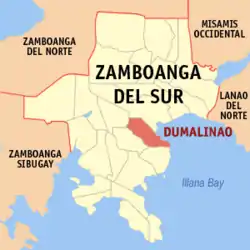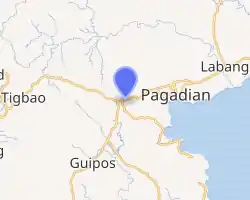Dumalinao
Dumalinao, officially the Municipality of Dumalinao (Cebuano: Lungsod sa Dumalinao; Subanen: Benwa Dumalinao; Chavacano: Municipalidad de Dumalinao; Tagalog: Bayan ng Dumalinao), is a 4th class municipality in the province of Zamboanga del Sur, Philippines. According to the 2015 census, it has a population of 32,013 people. [3]
Dumalinao | |
|---|---|
| Municipality of Dumalinao | |
 Map of Zamboanga del Sur with Dumalinao highlighted | |
OpenStreetMap 
| |
.svg.png.webp) Dumalinao Location within the Philippines | |
| Coordinates: 7°49′N 123°22′E | |
| Country | |
| Region | Zamboanga Peninsula (Region IX) |
| Province | Zamboanga del Sur |
| District | 2nd District |
| Founded | June 16, 1956 |
| Barangays | 30 (see Barangays) |
| Government | |
| • Type | Sangguniang Bayan |
| • Mayor | Junaflor S. Cerilles |
| • Vice Mayor | Wilfredo L. Malong Sr. |
| • Representative | Leonardo L. Babasa Jr. |
| • Electorate | 20,929 voters (2019) |
| Area | |
| • Total | 117.64 km2 (45.42 sq mi) |
| Elevation | 319 m (1,047 ft) |
| Population | |
| • Total | 32,013 |
| • Density | 270/km2 (700/sq mi) |
| • Households | 7,064 |
| Economy | |
| • Income class | 4th municipal income class |
| • Poverty incidence | 43.06% (2015)[4] |
| • Revenue | ₱90,459,166.45 (2016) |
| Time zone | UTC+8 (PST) |
| ZIP code | 7015 |
| PSGC | |
| IDD : area code | +63 (0)62 |
| Climate type | tropical climate |
| Native languages | Subanon Cebuano Chavacano Tagalog |
| Website | www |
History
In 1956, the barrios of Dumalinao Proper, Bigong, Tigbao, Ticwas, Bulongating, Baguitan, Pantad, Napulan, Tagulo, Camanga, Margang, Sibucao, Tina, Guling, Miculong, Baga, Rebucon, and Mambilik were separated from Pagadian and constituted into Dumalinao through House Bill No. 5000, which later became Republic Act No. 1593 and approved on June 16, 1956.[5] The person responsible for sponsoring the bill was Congressman Q. Ubay of Zamboanga del Norte since during that time, Zamboanga del Sur had no congressman; Rep. Roseller T. Lim that time had been elected to the Senate in the 1955 special election.[6]
Martin D. Raluto was first appointed municipal mayor with Guillermo Talaid as his vice mayor. The new town then had four councilors: Vicente T. Labrado, Severino Ramas, Fulgencio Lauglaug, and Eniiego Gemina, although the latter did not serve. Raluto held the position of municipal mayor until his death on June 11, 1969.[6] Ace William E. Cerilles is now the incumbent mayor.
Barangays
Dumalinao is politically subdivided into 30 barangays.
- Anonang
- Bag-ong Misamis
- Bag-ong Silao
- Baga
- Baloboan
- Banta-ao
- Bibilik
- Calingayan
- Camalig
- Camanga
- Cuatro-cuatro
- Locuban
- Malasik
- Mama (San Juan)
- Matab-ang
- Mecolong
- Metokong
- Motosawa
- Pag-asa (Poblacion)
- Paglaum (Poblacion)
- Pantad
- Piniglibano
- Rebokon
- San Agustin
- Sebucao
- Sumadat
- Tikwas
- Tina
- Tubo-Pait
- Upper Dumalinao
Climate
| Climate data for Dumalinao, Zamboanga del Sur | |||||||||||||
|---|---|---|---|---|---|---|---|---|---|---|---|---|---|
| Month | Jan | Feb | Mar | Apr | May | Jun | Jul | Aug | Sep | Oct | Nov | Dec | Year |
| Average high °C (°F) | 29 (84) |
30 (86) |
30 (86) |
30 (86) |
29 (84) |
28 (82) |
27 (81) |
27 (81) |
28 (82) |
28 (82) |
29 (84) |
29 (84) |
29 (84) |
| Average low °C (°F) | 20 (68) |
20 (68) |
21 (70) |
22 (72) |
23 (73) |
23 (73) |
22 (72) |
22 (72) |
22 (72) |
22 (72) |
22 (72) |
20 (68) |
22 (71) |
| Average precipitation mm (inches) | 22 (0.9) |
18 (0.7) |
23 (0.9) |
24 (0.9) |
67 (2.6) |
120 (4.7) |
132 (5.2) |
156 (6.1) |
119 (4.7) |
124 (4.9) |
54 (2.1) |
24 (0.9) |
883 (34.6) |
| Average rainy days | 9.4 | 9.1 | 11.5 | 11.9 | 20.1 | 22.5 | 22.4 | 23.2 | 21.5 | 22.2 | 15.7 | 11.5 | 201 |
| Source: Meteoblue [7] | |||||||||||||
Demographics
| Year | Pop. | ±% p.a. |
|---|---|---|
| 1960 | 29,986 | — |
| 1970 | 34,169 | +1.31% |
| 1975 | 36,993 | +1.61% |
| 1980 | 36,604 | −0.21% |
| 1990 | 45,026 | +2.09% |
| 1995 | 23,985 | −11.13% |
| 2000 | 26,030 | +1.77% |
| 2007 | 29,732 | +1.85% |
| 2010 | 30,691 | +1.16% |
| 2015 | 32,013 | +0.81% |
| Source: Philippine Statistics Authority [3] [8] [9][10] | ||
Economy
Agriculture is the main economic activity as well as the number one source of livelihood of the people, although Dumalinao is a coastal town. The town is one of the major rice granaries of Zamboanga del Sur as 5,998 hectares of the land area is devoted to agricultural production. The crops planted on these lands include rice, corn, coconut, banana, and root crops. Corn, in particular, is the municipality's main agricultural crop. An estimated 2,837 hectares of the land are utilized for corn production, with an average of 30 ca-vans per hectare (or 8.5 million kilos annually). On top of that, Dumalinao's climate is very conducive for growing corn, so much so that farmers usually get to have two croppings of corn per year. An estimated value of Php 51 million comes from the annual production of corn.[6]
References
- Municipality of Dumalinao | (DILG)
- "Province: Zamboanga del Sur". PSGC Interactive. Quezon City, Philippines: Philippine Statistics Authority. Retrieved 12 November 2016.
- Census of Population (2015). "Region IX (Zamboanga Peninsula)". Total Population by Province, City, Municipality and Barangay. PSA. Retrieved 20 June 2016.
- "PSA releases the 2015 Municipal and City Level Poverty Estimates". Quezon City, Philippines. Retrieved 12 October 2019.
- "An Act Creating Municipality of Dumalinao in the Province of Zamboanga Del Sur". LawPH.com. Archived from the original on 2012-07-10. Retrieved 2011-04-12.
- Dumalinao Profile
- "Dumalinao: Average Temperatures and Rainfall". Meteoblue. Retrieved 1 May 2020.
- Census of Population and Housing (2010). "Region IX (Zamboanga Peninsula)". Total Population by Province, City, Municipality and Barangay. NSO. Retrieved 29 June 2016.
- Censuses of Population (1903–2007). "Region IX (Zamboanga Peninsula)". Table 1. Population Enumerated in Various Censuses by Province/Highly Urbanized City: 1903 to 2007. NSO.
- "Province of Zamboanga del Sur". Municipality Population Data. Local Water Utilities Administration Research Division. Retrieved 17 December 2016.